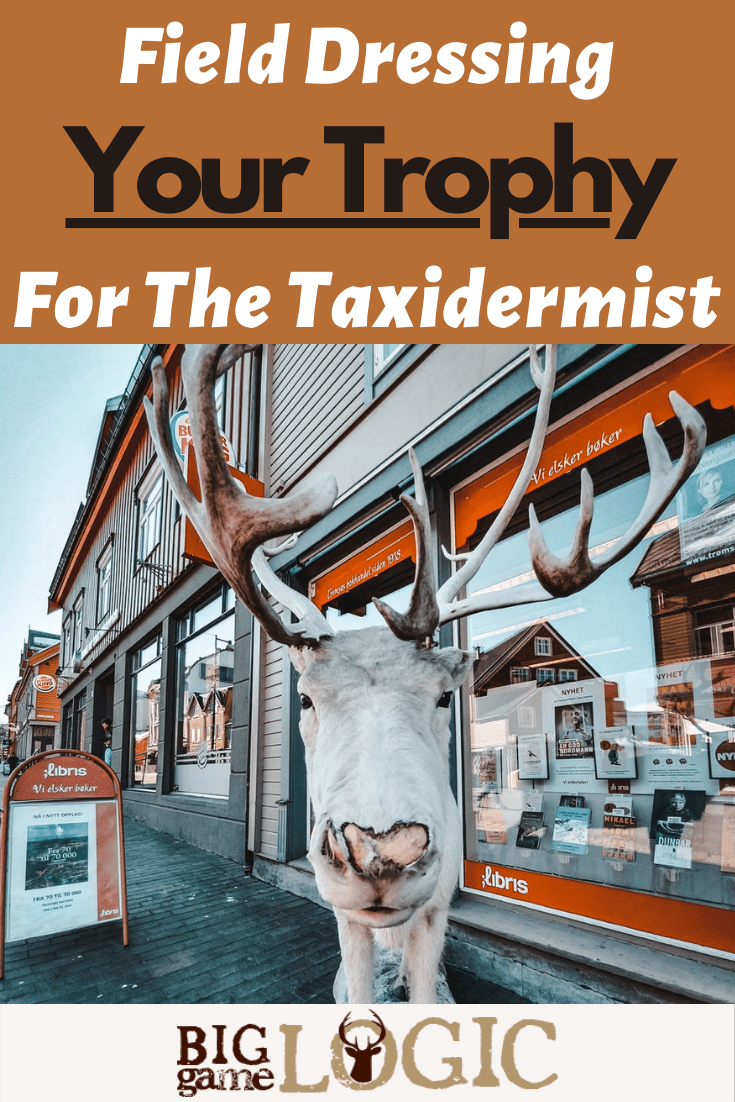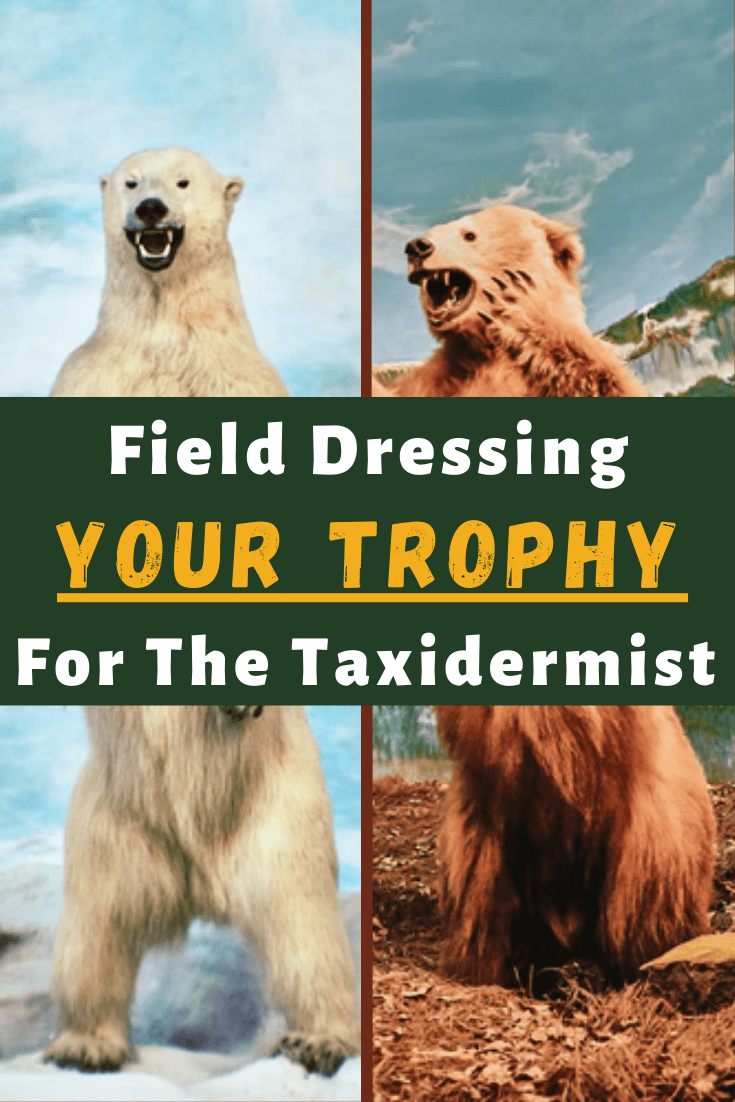Big Game Logic is reader-supported. When you buy through links on our site, we may earn an affiliate commission.
For those hunters privileged enough to harvest a once in a lifetime trophy animal, taking the proper steps after the animal is down, could mean the difference between a beautiful wall hanger and a devastating phone call from your taxidermist.
The art of skinning takes time and experience to develop; I used to practice on smaller game like coyotes and foxes to hone my skills. There are times when simply loading up the trophy and racing to the local taxidermist is possible, but for those times when your adventure takes you a bit further back, knowing how to properly prepare your cape or hide is key to a great mount.
Before your prize hits the ground, I will start by saying that shot placement starts it all. Bullets have the potential of making big holes and damage; abstain from putting the cross hairs on the forehead of a 190 buck. As an outfitter, I encourage well placed shoulder shots; this typically ensures a swift take down with little damage to the cape.
Next, if you a 2,000 vertical feet up on a rocky outcropping, don’t kick the carcass over the ledge…..laugh but I have heard of this. Move the animal as little as possible and if you must move it to begin working, drag it on a tarp of jacket. This will help minimize damage and accidentally cutting hair on rocks. Now that you have your trophy in a safe secure area to begin work, a good knife (usually a small very sharp knife) and some tanning salt are the only things you’ll need.
Which Mount Are Your Preparing For?
The mount you intend the trophy to become will dictate the initial cuts, for example a shoulder mount will mean a dorsal cut up the back versus a rug that will have cuts down each limb and up the underside of the animal. Despite what your grandfather taught you, the first cut is not the throat! Never cut the throat, if the heart is no longer pumping the only thing you were successful in doing was getting a taxidermist cursing you name. Let’s get started.
For a shoulder mount the initial cuts will run up the spine from well behind the shoulder towards the base of the skull. From there the cut will “V” to the back of the horn/antlers bases. Return to the area behind the shoulder and cut all the way around the body. I typically come down and stay well behind the arm pit of the animal and actually include some of the foreleg as a part of the cape. To do that you will have to run a cut up the back of the foreleg, just above the armpit and adjoin the cut that went completely around the body. As you begin to take the cape off, skin slowly and carefully, it is important that all the meat remains on the body and not the cape.
As you skin towards the head, and move up to the horn/antlers be careful to skin around the bases very carefully. Keeping all the hide intact as you skin around the bases will help with the finished product. The ears are based further back into the skull then usually realized, located the canal and cut it off close to the skull. Next come the eyes, and again it is important to take you time. I normally stick my index finger into the back of the eyelid area to ensure I skin close to the skull and do not accidentally cut any of the eyelid material away. Making your way forward on the eye, as you begin to reach the front of the eye, remember the orbital gland found in the deer species.
Begin to cut closely to the skull and in essence, “scoop” out the hide that fills the small pocket. Continue working your way down to the end of the mouth/nose area. As you skin near the mouth, watch running your knife on the teeth, it knocks the edge off with only a couple hits.
Be sure to leave all out the lip material attached to the cape; a mount with no lips just looks plain funny! As you move down onto the nose, you will be able o feel where the bone ends and cartilage begins. You will have to start on the top side of the cartilage and cut it off of the skull and keep the inner skin of the nostrils apart of the cape. After the cape is completely removed, the horns/antlers can be removed from the rest of the skull. Clean the skull plate up a bit while the meat is fresh and easy to remove. At this time you can load your packs and head back to camp, if the cape can put in a freezer right away, great! If that is not an option, your work back at camp is going to eat up a few hours to further prepare the cape.
Before any salt can be used, you must finish the work you started in the bush or on the side of the mountain. Do not wait too long, the sooner you can get the cape finished and salted, the better the quality of cape. Ears can be difficult, a split up ear on a moose can make a grown man cry, but it is important to skin the back side of the ear away from the cartilage….all the way to the edges and tips. A 1 inch wide, partially sharpened stick can be used like a screwdriver to pry the hide off the cartilage. Next the lips need to be split to the extreme outside edge. Using your fingers as a guide, place them on the outside edge of the lip and begin splitting the lips.
Think of it like you are attempting to skin all the meaty inner part of the lip away from the hide until you reach the outer most edge. It is important to use your finger as a guide to skin towards, you will have a better feel as you approach the edge and are less likely to skin through and into your fingers. The eyes and the nose area should be done in a similar fashion, keep your finger of one hand on the fur side of the hide and skin towards the outer edges. Imagine attempting to skin the entire outer hide from the inner flesh or cartilage, but stopping just before you cut through the cape.
There will always be a certain amount of thin meat left on the cape in the area of the head; I make cuts through the meat to expose the hide below in a grid like pattern with one inch squares. This ensures salt will be able to properly penetrate. If each edge; eye lids, lips, ears, and nose feel adequately thinned down and/or split, lay the cape spread out on a tarp and salt the heck out of it. Rub about 1/8 inch thick of salt on the entire cape, be certain to rub the edges of the cape and facial area as well. Roll the salted hide up for a day, after you may want to shake out the wet salt and apply a thin layer of new salt for the trek out to civilization.
For skinning a life size mount, use a dorsal incision down the length of the spine from the tail head to the base of the skull. In addition, one cut down the back side of each leg is needed to remove the legs. This way of removing the hide works well with animals with shorter underbelly hair. It is important to remember the genitals when skinning for a life size mount.
On an animal with a pad on its feet, do not cut through the pad, leave about ¼ of fur on the edge of the pad as you cut around it to remove the toe bones. The small bones of the claws must be removed down to the last one. Hooves have and bone inside the hoof shell that must be removed. Carefully use the tip of your knife and move around the edges and under the bone to cut attachments. I do find that a pair of pliers or vise grips makes it easier to keep hold and pull.
Rug mounts are skinned with the first incisions being made on the underside of the animal. Life size mounts can be skinned with this method, and in the case of cats (cougar, lynx, and bobcat) it is the best way to “life size” skin because the hair is thicker on the underbelly. This will ensure that the stitches are hidden. With the animal flat on its back, start between the lower jaw and run a straight line cut down to the anus. Then on the back legs, run a cut down the back of the legs to the “tail” side of the anus.
The incisions on the front legs are important and should run down the center of the leg to the incision made down the middle of the animal. Try to keep the cut from the middle of the pad, down the middle of the legs and “T” into the belly cut. Too much on one side of the leg or the other and the legs of the rug mount will not lay proper. Continue to remove the hide carefully, leaving as little or no meat or fat, and remove skull, feet and tail bone. All head preps are similar, with eyes, ears, nose and lips being equally important to do well.
Conclusion
Improper field care can completely ruin a once in a lifetime hunt. Being able to immortalize the trophy in a mount is the ultimate show of appreciation and respect. Spend some time with your taxidermist, get to know what they like and dislike. In most circumstances, your taxidermist will jump at the chance to share some information on how to properly field care for your trophy. After all it is impossible to make a silk purse out of a sow’s ear! Good luck and happy hunting
Share to Pinterest




